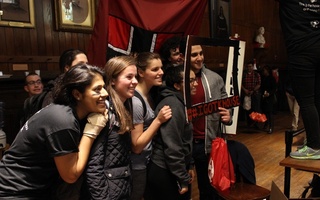Freshmen must enter their blocking and linking preferences today. And with a new neighborhood blocking option that allows two groups of freshmen to link with each other, first-years may face a more flexible social network when they enter the House system.
Last May, the Committee on House Life and the Undergraduate Council passed an initiative to allow a blocking group of up to eight people to link with another group. The two blocking groups would be assigned to nearby Houses. Under this new system, the Houses are divided into four “neighborhoods.” Cabot, Currier, and Pforzheimer make up one neighborhood; Adams, Lowell, and Quincy comprise another; Dunster, Mather, and Leverett create the third; and Eliot, Kirkland, and Winthrop round out the last neighborhood.
“I think it’s caused a lot of restructuring of groups last minute,” Frank A. DeSimone ’09 said about the neighborhood blocking option.
DeSimone has chosen to block with two of his roommates, a friend, and four “people [they] do not know.”
These people who DeSimone barely knows want to link with other freshmen with whom he said he has a “bad history.”
But for DeSimone, linking may have advantages outside of strengthening budding freshman friendships.
It “guarantees we won’t live with them,” he said.
Dara M. Wilson ’09 and Tiana I. Barros ’09 shared similar sentiments in Annenberg Hall last night.
“It’s a good way to keep your enemies out of your House,” Wilson said.
Barros, sitting beside her, added, “Keep your friends close but your enemies closer.”
“And at arm’s length,” Wilson said without skipping a beat.
Some freshmen have been analyzing the sociology of the system.
Lena Chen ’09 and her blockmates initially considered linking with another large blocking group. But she wrote in an e-mail last week that this could potentially lead to a “fate worse than death.”
“We probably do have a better chance of getting quadded [because] we’re big,” wrote Chen, who is also a Crimson editor for Fifteen Minutes.
But unlike DeSimone, Chen said that linking would guarantee day-to-day interaction with people with whom she aligned.
“Our primary concern wasn’t whether we were going to get quadded, but whether we were going to get quadded with people we don’t want to see,” Chen said yesterday. This situation would have been the “worst-case scenario,” she added.
Chen and her blockmates have since decided not to link with the other group.
But according to Director of Housing Joshua McIntosh, size does not matter.
“Bigger, or smaller, blocking groups have no impact on how students are randomly assigned to the houses,” McIntosh wrote in an e-mail.
Several freshmen said they were ambivalent about the advantages of neighborhood blocking.
“I’m not even getting into linking because blocking is so stressful,” Indira Phukan ’09 said. “It’s such a struggle to figure out a group.”
“The neighborhooding did help a lot,” Kyra A Hill ’09 said, but added that it was painful “classifying your friends” into either a close-knit blocking group or an outer-circle linking group.
With housing assignments a little more than a week away, other freshmen have seen the blocking experience as an opportunity to express their artistic talent.
“The tight-knit groups are fighting too because they got to with fringe friends pushing in for last spots in hot groups,” a verse of a rap written by Grant M. Damon ’09 reads. “I thought you had just committed to the Lost Crew, when awesome is to suck as the River is to Quad, fool.”
As for a solution to making the system less stressful, Diep N. Vo ’09 suggested expanding blocking group size.
Neighborhood blocking did not address the fact that “your friends [may] have different friends,” Vo said.
But Dan A. Svirsky ’09 suggested the opposite.
“The best solution would be to cut down” blocking group size, he said.
It’s easier to identify your true, closest friends than those more on the periphery, Svirsky added.
And given the choice to go through blocking again or have his “ring toe cut off,” Svirsky said he would gladly choose the latter.
—Staff writer Katherine M. Gray can be reached at kmgray@fas.harvard.edu.
Read more in News
200 Gather To Remember Positive Psych PioneerRecommended Articles
-
House Lottery Results ArriveWith visions of Quad and River houses dancing in their heads, members of the Class of 1996 awoke yesterday to
-
No HeadlineThe work of the eleven against Dartmouth's heavy team deserves praise in some respects though there were several very weak
-
HARLOW TACTICS TO PUZZLE NASSAU BULLIES, 'DAILY' SAYSPrinceton has come a long way since the Williams game, and the direction is not up Most of us thought
-
 Housing Day Terms to Know
Housing Day Terms to Know -
 How to Finesse Your Way Into a Blocking Group
How to Finesse Your Way Into a Blocking Group













